Olive View/UCLA Medical Center
May 13, 2009
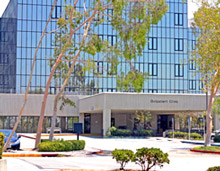 Northeast Valley residents can look forward to greatly expanded emergency room services at Olive View/UCLA Medical Center under the hospital’s new ER project. On April 16, Yaroslavsky and other officials broke ground for new facility, which will offer 51 treatment areas in 32,000 sq. ft of space, virtually doubling the size of the existing ER, which currently handles 42,000 emergency and 19,000 urgent care visits annually. Among the numerous state of the art amenities will be 16 adult critical care rooms, six pediatric treatment rooms, five OB/GYN exam rooms, and a new 11,000 sq. ft. acute care/isolation unit with 15 two-person inpatient isolation rooms for patients with infectious diseases.
Northeast Valley residents can look forward to greatly expanded emergency room services at Olive View/UCLA Medical Center under the hospital’s new ER project. On April 16, Yaroslavsky and other officials broke ground for new facility, which will offer 51 treatment areas in 32,000 sq. ft of space, virtually doubling the size of the existing ER, which currently handles 42,000 emergency and 19,000 urgent care visits annually. Among the numerous state of the art amenities will be 16 adult critical care rooms, six pediatric treatment rooms, five OB/GYN exam rooms, and a new 11,000 sq. ft. acute care/isolation unit with 15 two-person inpatient isolation rooms for patients with infectious diseases.
State adds little Las Flores Canyon as new parkland in Malibu
May 13, 2009
 A generous property donation by Pepperdine University has added 72 acres of prime Santa Monica Mountains open space to California’s state parks system. Known as Little Las Flores Canyon, the parcel sits above the City of Malibu and adjoins the 1,255-acre Tuna Canyon Park, and becomes part of 18,000 acres of contiguous protected open space reaching from Topanga State Park west to Las Flores Canyon.
A generous property donation by Pepperdine University has added 72 acres of prime Santa Monica Mountains open space to California’s state parks system. Known as Little Las Flores Canyon, the parcel sits above the City of Malibu and adjoins the 1,255-acre Tuna Canyon Park, and becomes part of 18,000 acres of contiguous protected open space reaching from Topanga State Park west to Las Flores Canyon.
LACMA: A picture of progress
May 13, 2009
It’s called “The Transformation”—a small catchphrase for the hugely ambitious, two-phase expansion of the Los Angeles County Museum of Art.
 Already, 60,000 square feet of gallery space has been added with the opening in 2008 of the Broad Contemporary Art Museum (BCAM), designed by Pritzker Prize-winning architect Renzo Piano. What’s more, construction is now finished on an open-air pavilion and a concourse that connects the east and west sides of LACMA’s 20-acre mid-city campus.
Already, 60,000 square feet of gallery space has been added with the opening in 2008 of the Broad Contemporary Art Museum (BCAM), designed by Pritzker Prize-winning architect Renzo Piano. What’s more, construction is now finished on an open-air pavilion and a concourse that connects the east and west sides of LACMA’s 20-acre mid-city campus.
Another hallmark of the transformation’s first phase: the installation of stunning public artworks, including Topanga Artist Chris Burden’s Urban Light, a neatly aligned collection of 202 vintage Los Angeles street lamps that has drawn crowds of locals and tourists alike.
All this was financed by $201 million in donations—a figure that LACMA officials say surpassed their fundraising goal by $51 million.
 So now it’s on to phase two, which is well underway. The centerpiece this time is the Lynda and Stewart Resnick Exhibition Pavillion, also designed by architect Renzo Piano. The Resnicks donated $55 million in funding and artwork to construct the new exhibition space, located just north of the BCAM.
So now it’s on to phase two, which is well underway. The centerpiece this time is the Lynda and Stewart Resnick Exhibition Pavillion, also designed by architect Renzo Piano. The Resnicks donated $55 million in funding and artwork to construct the new exhibition space, located just north of the BCAM.
The single-story pavilion, scheduled for completion in the summer of 2010, will feature a twenty-foot ceiling and no interior walls, creating a flexible floor plan that can accommodate any kind of exhibition.
Also included in this phase of construction will be the complete rehabilitation of LACMA West, the 300,000 square-foot former May Company department store, built in the late 1930s as a gateway to the historic Miracle Mile.
Since the earliest stages of planning, Supervisor Yaroslavsky has been closely involved with LACMA’s transformation, championing the decade-long project in philanthropic and government circles. He is widely considered to be the board’s most ardent advocate of the arts.
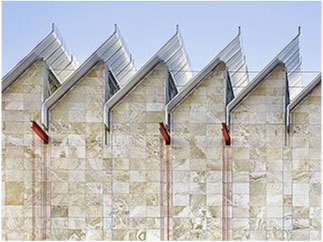 “LACMA’s expansion has been—and will continue to be—a boon for all of Los Angeles,” says the supervisor, whose district includes the museum. “Whether through its architecture, its collections, its outdoor sculptures or its stellar public programs, LACMA is creating a museum in a park that welcomes every resident of Los Angeles County and millions of visitors from throughout the world.”
“LACMA’s expansion has been—and will continue to be—a boon for all of Los Angeles,” says the supervisor, whose district includes the museum. “Whether through its architecture, its collections, its outdoor sculptures or its stellar public programs, LACMA is creating a museum in a park that welcomes every resident of Los Angeles County and millions of visitors from throughout the world.”
For pictures and more information on LACMA’s transformation, click here.
Going solar in SoCal
May 8, 2009
Los Angeles County has created an innovative, interactive “Solar Map” to help residents, business owners and public property managers quickly figure out how much money and energy they can save by switching to solar.
The new map covers more than 3,000 acres of territory, making it the largest of its kind in terms of geographic scope. Users simply enter their address and zip code, and the website automatically calculates how much electricity they can generate through roof-top solar panels, how much money they can save annually on utility bills and how much carbon dioxide emissions they can reduce every year.
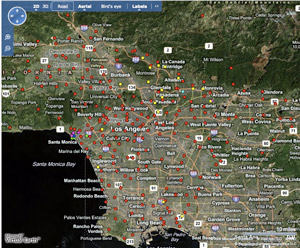 Los Angeles County’s solar map also gives people fast access to a list of licensed installers so they can get cost estimates and information about tax incentives and rebates in their neighborhoods.
Los Angeles County’s solar map also gives people fast access to a list of licensed installers so they can get cost estimates and information about tax incentives and rebates in their neighborhoods.
Existing incentives from utilities and the federal government offer up to a 62% discount for residential customers in the City of Los Angeles and up to 45% for Southern California Edison customers. With these incentives, the price of solar costs an average of between 10- and 15-cents per kilowatt hour—the amount of energy it takes to burn a 100 watt light bulb for 10 hours. That’s comparable to the cost of electricity purchased from Southern California Edison and the Department of Water and Power. Going solar will also help create a hedge against ever-rising utility costs since the cost of sunshine never goes up.
Solar power contractors will also benefit from the map’s detailed aerial pictures. They’ll no longer need to climb roofs to determine whether solar will work on a particular building. The site develops its estimate of solar capacity by measuring the roof’s pitch, orientation, shadow effects and architectural or structural elements that could reduce usable area.
Over time, contractor reliance on this technology is expected to help lower installation costs for all residents.
The Solar Map website was created through a partnership between the county’s Internal Services Department, Chief Information Office, CH2M HILL, Southern California Edison and several local cities. It cost a relatively small $93,500 by taking advantage of the County’s existing aerial imagery and applying new computer technology to get the desired information.
By creating a one-stop website for people interested in taking advantage of southern California’s solar-friendly climate, the website’s designers, who modeled Los Angeles County’s solar map after similar projects in San Francisco and other cities, hope it will help facilitate the burgeoning green power industry here, thereby reducing utility costs, fighting global warming and creating new green jobs.
As Supervisor Yaroslavsky put it during an April press conference to unveil the map: “Solar makes sense in Los Angeles and in Southern California” since “this is one of the capitols of sunshine on the globe.”
Extreme makeover: L.A. River edition
May 7, 2009
For decades, the Tujunga Wash was little more than an eye-sore, a concrete flood-control channel snaking through Valley subdivisions, a tributary of the equally blighted Los Angeles River. Its one purpose: to move runoff to the ocean.
No more.
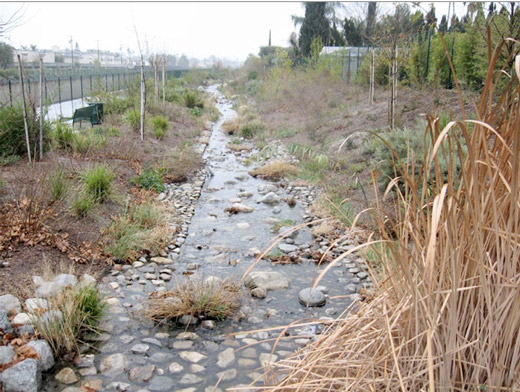
A stretch of the Tujunga Wash between Vanowen and Oxnard streets in the Third District has now become a model for urban environmentalists, complete with hundreds of new trees and plants, a bike path and a stream that allows rainwater to seep into the aquifer rather than run straight to the sea.
It is, in sum, a beautiful blend of conservation and recreation.
The effort has been so successful that a second greenway project for the Tujunga Wash is now being launched by the Army Corps of Engineers with nearly $4 million in stimulus funds from Washington. Los Angeles County is expected to contribute an additional $1.25 million.
Scheduled for completion in early 2011, it will run from Vanowen to Sherman Way—a 3,000-foot mirror-image extension of the earlier greenway and stream restoration project that Supervisor Yaroslavsky has praised as “a template for the rest of the Los Angeles River.”
The greening of Tujunga Wash is, in fact, just one facet of an ambitious makeover
of the 51-mile-long L.A. River that was adopted in 1996 by the Board of Supervisors and involves a partnership between the city and county of Los Angeles, the U.S. Army Corps of Engineers and non-profit community groups that have raised money and supplied labor to replant sections of the river. The mission: to protect the river’s flood capabilities while enhancing adjacent communities with parks, recreational opportunities, environmental restoration, economic development and civic pride.
Already, segments of the river—near Griffith Park, for example—have been transformed with popular bike paths and thick natural vegetation that has attracted migratory birds and other wildlife. Some plans call for the removal of concrete along certain sections of the river to restore it to an even more natural state.
Work on the latest segment of the Tujunga Wash, which feeds runoff from Hansen Dam to the L.A. River, is expected to begin in summer, 2010, and be finished in six months. According to the Army Corps of Engineers, the project will bring an additional 14 acres of open space and native habitat to the area, as well as extend the stream that was earlier created by the county to cleanse runoff and replenish the aquifer.
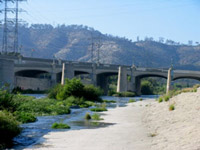 “Continuing the work on this project is important to helping restore degraded habitat along the channel, providing nesting opportunities for migratory birds and establishing a corridor for wildlife movements,” said Col. Thomas H. Magness IV, commander of the corps’ Los Angeles District.
“Continuing the work on this project is important to helping restore degraded habitat along the channel, providing nesting opportunities for migratory birds and establishing a corridor for wildlife movements,” said Col. Thomas H. Magness IV, commander of the corps’ Los Angeles District.
The project received federal stimulus dollars, according to Army Corps of Engineer officials, because it’s expected to create an estimated 32 jobs directly related to the work and an additional 55 jobs in industries supplying or supporting the construction, performing operations and maintenance and selling goods and services to the workers and their families.
Merck no match for L.A. County pharmacy director
May 5, 2009
L.A County Pharmacy Director Amy Gutierrez was determined to make pharmaceutical giant Merck & Co. live by its corporate motto: “Where patients come first.”
Merck, she says, was balking at providing free doses of the cervical cancer vaccine Gardasil to uninsured young women no longer eligible to receive the drug through a state administered program.
Gardasil, which has proven to be about 75% effective in preventing cervical cancer, is recommended for women between the ages of 9 and 26. But California offers free vaccines to uninsured women only up to the age of 18. Gutierrez wanted to make sure that no woman would be denied the vaccine because of her age or insurance status.
Merck executives saw it differently.
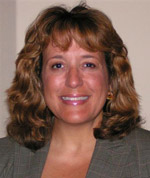
L.A County Pharmacy Director Amy Gutierrez
“It was an arbitrary decision that I thought was insulting,” says Gutierrez, who’s headed the pharmacy for three years.
Last summer, Gutierrez began pushing Merck hard on the phone and in writing, with help from Dr. Robert Israel, an OB-GYN who oversees women’s health clinics at LAC+USC medical center. She also enlisted the interim chief medical officer of the county’s health services department, Dr. Robert G. Splawn.
In July, the two co-signed a sharply worded letter to Merck, explaining once again the importance of providing Gardasil to uninsured and vulnerable women between the ages of 19 and 26 at county medical facilities. Denying the vaccine to these patients simply because they’re being seen in a public hospital or clinic, they wrote, “is not logical, nor is it consistent with the stated objectives” of Merck’s patient assistance program, to provide vaccines to those who can’t pay.
Not so subtly, the two also reminded Merck that Los Angeles County is a big customer, spending more than $9 million annually on the company’s various drugs.
Still, Merck held fast to its position, saying it was waiting for the results of a pilot program with public agencies in several states before proceeding, a program for which California had not applied. So Gutierrez and her staff decided to turn up the heat, making Merck aware that the county had begun scrutinizing certain big-ticket purchases from the company.
Concerned by the county’s move, Merck executives called to discuss the situation. But the pharmacy director says she told them: “There’s only one item on the agenda that I want to talk about.”
One month later, in mid-December, Gutierrez says she got “a great Christmas present”—an e-mail from a top Merck executive.
“Hello Dr. Gutierrez,” the note began, “I wanted to confirm that we have altered our policy such that public institutions and entities are now eligible to utilize the current Vaccine Patient Assistance Program in the same manner and to the same extent as private institutions and entities.”
Merck’s dramatic shift in policy was not only good news for Los Angeles County but for every county in the U.S., where the vaccine and other designated drugs can now be distributed through public hospitals and clinics.
“I never thought I could do something to change the policy,” says Gutierrez, whose three daughters have all been vaccinated with Gardasil. “But if you have enough persistence, you can pull it off.”
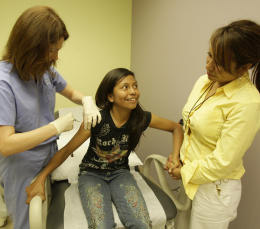 In February, the county started administering Gardasil through the LAC+USC Healthcare Networks. Dr. Israel, the women’s health expert and a USC professor, says dosages are being provided to about 25 women a month. In the weeks ahead, he says, other county facilities, such as Olive View Hospital, will begin the vaccination program.
In February, the county started administering Gardasil through the LAC+USC Healthcare Networks. Dr. Israel, the women’s health expert and a USC professor, says dosages are being provided to about 25 women a month. In the weeks ahead, he says, other county facilities, such as Olive View Hospital, will begin the vaccination program.
Even then, however, he does not expect the numbers of participants to be large because, for the most part, women between the ages of 19 and 26 who show up at county facilities with gynecological issues already are confronting serious medical problems. For them, he says, the vaccine is down the list of priorities.
“We opened the door,” he says of the vaccine’s availability. “I didn’t expect we were going to kick the door down.”
Health professionals hope that, in the future, there’ll be no need to provide Gardasil in this older age group. The goal, they say, is for the vaccine to be administered to all girls at an early age, before they have sexual intercourse and become vulnerable to strains of the human papilloma virus that cause cervical cancer.
Until then, Gutierrez says, she’ll continue to spread the word. “If we can in any way impact cervical cancer in L.A., we’ve succeeded.”









 Check for the latest closure information
Check for the latest closure information








